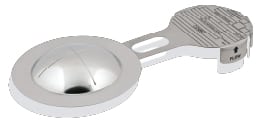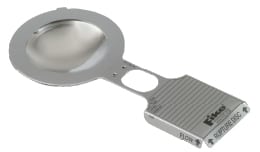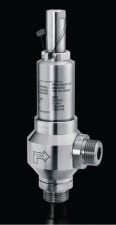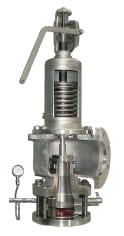The lowest KR values
in rupture discs
 |
KR values are used to determine the frictional flow loss in rupture discs. While the perception is that all rupture discs have high KR values, this company’s FAS (Forward Acting Scored) and PRO+ (Precision Reverse Operating) discs debunk this perception by offering the best flow characteristics available in a rupture disc. Having a lower KR value means that the FAS [KRG = 0.223 (gas), KRL = 0.19 (liquid)] and PRO+ (KR = 0.29) rupture discs provide a larger opening that allows a greater flowrate than other rupture discs on the market, says the company. The ability of these two discs to reach such low KR values allows for better flow and faster system relief in the event of overpressurization. The FAS and PRO+ are both used for safety-relief valve isolation. The FAS is used in high-pressure applications, while the PRO+ is ideal for situations requiring a lower burst pressure. The PRO+ is also suitable for isolation relief valves in high-cycling applications. — Oseco, Broken Arrow, Okla.
A system that manages
all overpressure relief devices
.jpeg) |
This company has introduced Relief Device Manager (RDM) for optimizing the safety, integrity and total ownership of overpressure relief devices, including rupture disks; buckling-pin relief valves; safety and pressure-relief valves; tank vents; flame arrestors; and explosion vents. This Windows-based system provides peace of mind to plant operators and owners by continuously monitoring overpressure relief devices. RDM provides warnings, alarms and performance history if events compromise the integrity of pressure safety management systems. RDM was designed because overpressure relief devices, such as rupture disks, activate instantaneously, which presents challenges to process plant owners and operators in pinpointing precise operating conditions of an overpressure event. Without RDM, inaccurate conclusions regarding the relationship between process conditions and overpressure relief devices can be made, risking repeated incidences and compromised safety. Inaccurate conclusions are frustrating, if devices are bursting frequently without the ability to diagnose causes, or if you are trying to maximize longevity of overpressure relief investments through precise replacement schedules. — BS&B Safety Systems, Tulsa, Okla.
 |
Reverse-acting rupture discs
for aggressive, sanitary applications
The Axius reverse-acting rupture (bursting) disc is said to represent a revolutionary advancement in high-performance pressure-relief technology. The manufacturer has continued to expand Axius capabilities, since its introduction in 2005, by offering higher burst pressure, a sanitary version and a range of larger sizes. Axius is designed to be used in aggressive chemical, pharmaceutical and sanitary applications, and typically outperforms all other types of rupture discs in these applications, says the company. Axius rupture discs are unique because they have no score lines, no stress zones that can fatigue and a completely smooth process side. — Fike Corp., Blue Springs, Mo.
Micro-scored rupture discs
offer added benefits
This company has recently introduced its SCD (forward acting) and SCR (reverse buckling) rupture discs with micro-scored calibration sections. The patent-pending technology makes the discs very flexible so that scoring in six or more sections is possible instead of the usual four. This allows a better opening of the disc, reducing the risk of petal detachment, even at higher pressures, says the company. This technology is also very effective for the manufacture of high-performance reverse buckling discs for low-pressure bursting ranges. The discs react to excessive pressure in a few milliseconds without fragmentation, have a good resistance to corrosion and are especially suitable for protection of relief valves. The company has also recently tested new materials for rupture discs, such as titanium and tantalum. — Donadon SDD Srl., Corbetta, Milan, Italy
 |
Proportional venting assured
with these relief valves
RHPS Series PRV model proportional relief valves provide proportional venting of overpressures for piping systems up to 1-in. size. End connections include NPT female, BSPP female and BSPP male in sizes 1/4, 1/2, 3/4 and 1 in. Available threaded adapters convert from BSPP to NPT to allow for easy product installation. Valve operation is smooth, opening gradually and reseating accurately in proportion to the increase or decrease in pressure over the set pressure. RPV proportional relief valves feature 316L stainless steel construction of the body, trim and spring housing. Fluorocarbon or nitrile seats and seals can be chosen. Available set pressure ranges are: 145 to 580 psig; 580 to 1,160 psig; 1,160 to 2,170 psig; 2,170 to 4,060 psig; and 4,060 to 5,800 psig. Depending on the body size selected, flow coefficients (Cv) range from 0.49 to 4.36. Operating temperature is from –20 to 80°C. — Swagelok Co., Solon, Ohio
 |
Two layers deliver added benefits
with this rupture disc
The double-layer KUB-V-Series adds one vital feature that other rupture discs dont offer: Due to special reinforcement of the second protecting layer, it withstands twice the pressure in the reverse direction as it does in the venting direction. The two-layer design consists of one layer that handles the burst pressure by incorporating a buckling pin element brought into the dome by high-precision laser cutting. The second layer is a sealing membrane that isolates the burst-pressure-determining layer from harsh process conditions. As a result, the KUB-V-Series eliminates all three disadvantages ordinary single-layer reverse-acting disks have, namely: premature failure due to fatigue; pre-weakening of the dome by bringing in scores and grooves into the fragile burst membrane; and complicated mounting of the disk. The KUB-V is torque independent according to its eight-times thicker burst layer compared to scored designs, as the burst pressure is determined by the buckling pin formula and is independent of material thickness. — Rembe GmbH Safety + Control, Brilon, Germany
Protect operators from injury
with this steam vent head
This new range of VHT vent heads is suitable for vertical open-ended steam-vent pipes. The vent heads are designed to safely discharge dry steam to the atmosphere at low velocity, which protects personnel from injury, buildings from damage, and minimizes the nuisance of water spray on the surroundings. The new internal drain recovers condensate that would otherwise have been directed to an external drain and removes the possibility of hot condensate exceeding temperature limitations of local drainage. The VHT vent heads are manufactured from austenitic stainless steel for life-long, trouble-free operation. — Spirax Sarco Inc., Blythewood, S.C.